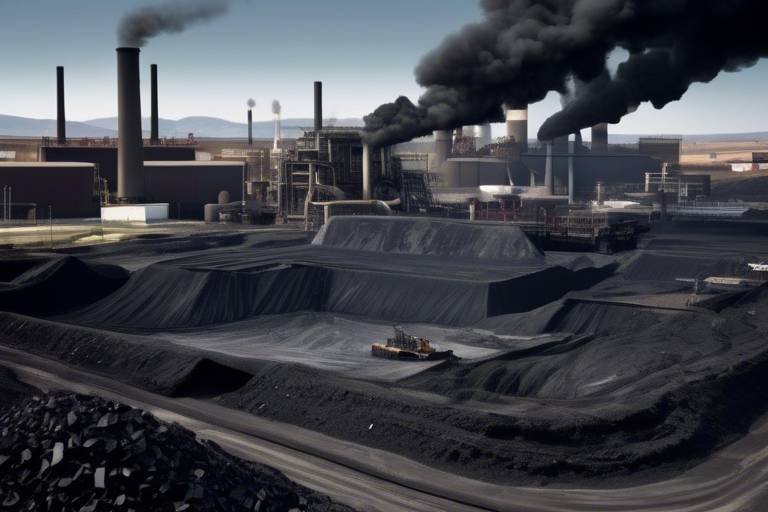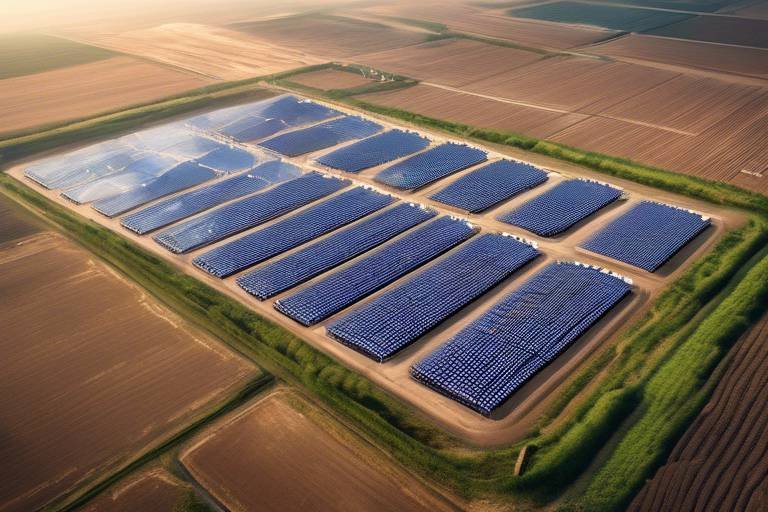Can Clean Coal Technology Alleviate Climate Change?
As the world grapples with the pressing issue of climate change, the quest for sustainable energy solutions has never been more urgent. One of the most contentious topics in this debate is the role of coal, a traditional energy source that has powered economies for centuries. However, with the advent of clean coal technology, there is a glimmer of hope that we can harness the energy potential of coal while mitigating its detrimental effects on the environment. But can clean coal technology truly alleviate climate change, or is it merely a band-aid solution?
To understand the potential of clean coal technology, we need to delve into its core mechanisms and processes. This technology aims to reduce greenhouse gas emissions associated with coal usage, allowing us to continue utilizing this abundant resource while minimizing its environmental footprint. By employing advanced techniques such as carbon capture and storage (CCS), coal washing, and beneficiation, we can transform the way coal is perceived in the energy landscape.
The environmental impact of traditional coal usage has been profound. The burning of coal releases a significant amount of carbon dioxide (CO2) and other harmful pollutants into the atmosphere, contributing to air quality issues and global warming. The need for cleaner alternatives has never been more apparent, as communities around the world suffer from the consequences of coal emissions. Clean coal technology offers a pathway to reduce these emissions, but it raises questions about its overall effectiveness and feasibility.
At the heart of clean coal technology lies the concept of carbon capture and storage (CCS). This innovative approach focuses on capturing CO2 emissions before they are released into the atmosphere and storing them safely underground. The process involves several critical steps: capturing the carbon at the source, transporting it to a storage site, and finally, securely storing it in geological formations. While CCS has shown promise in reducing emissions, it is not without its challenges. Economic and logistical hurdles must be addressed to ensure that this technology can be implemented on a large scale.
Furthermore, coal washing and beneficiation play a vital role in enhancing coal quality. By removing impurities from coal, these processes can significantly lower emissions when the coal is burned. This means that even as we continue to rely on coal as an energy source, we can do so in a way that is less harmful to the environment. The combination of these technologies could provide a more sustainable approach to coal usage, but it requires a commitment to innovation and investment.
Examining the economic viability of clean coal technology reveals a complex landscape. While the initial investments can be substantial, the potential returns—both in terms of environmental benefits and energy production—are significant. Additionally, clean coal technology must compete with rapidly advancing renewable energy sources, which are becoming increasingly cost-effective. The challenge lies in striking a balance between maintaining energy security and transitioning to cleaner alternatives.
Government incentives and policies are crucial in promoting clean coal technology. By providing funding for research and development, as well as encouraging adoption rates across the energy sector, governments can help pave the way for a cleaner energy future. However, the effectiveness of these policies will depend on their design and implementation, as well as the political will to support them.
As we analyze current market trends and future projections for clean coal technology, it becomes clear that its role in the global energy landscape is evolving. While it may not be a silver bullet for climate change, it offers a transitional solution that can bridge the gap between traditional coal usage and a more sustainable energy future. The potential impact of clean coal technology on climate change is still unfolding, but it remains a critical component of the broader conversation about energy, sustainability, and environmental responsibility.
- What is clean coal technology? Clean coal technology refers to a range of processes aimed at reducing the environmental impact of coal energy production, including carbon capture and storage.
- How does carbon capture and storage work? CCS captures carbon dioxide emissions from coal combustion, transports it, and stores it underground to prevent it from entering the atmosphere.
- What are the economic implications of clean coal technology? While initial investments can be high, the long-term benefits include reduced emissions and potential job creation in the clean energy sector.
- Can clean coal technology compete with renewable energy? Clean coal technology faces competition from renewables, which are becoming more cost-effective, but it can serve as a transitional solution.

The Basics of Clean Coal Technology
Understanding clean coal technology is essential in our quest to balance energy needs with environmental responsibility. At its core, clean coal technology encompasses a range of processes and methods designed to reduce the environmental impact of coal utilization while still allowing us to harness its energy. This technology aims to tackle the age-old dilemma of relying on coal—a resource that has powered economies for centuries—while addressing the pressing issue of greenhouse gas emissions that contribute to climate change.
One of the primary goals of clean coal technology is to minimize the carbon footprint associated with coal combustion. Traditional coal-fired power plants are notorious for their high emissions of carbon dioxide (CO2) and other pollutants. Clean coal technology incorporates various innovative approaches, including carbon capture and storage (CCS), which we will explore in detail later. By capturing CO2 emissions before they escape into the atmosphere, we can significantly mitigate the environmental impact of coal usage.
Another crucial aspect of clean coal technology is the process of coal washing and beneficiation. This involves treating coal to remove impurities such as sulfur and ash, which, when burned, contribute to air pollution and greenhouse gas emissions. By enhancing the quality of coal before it is used, we can achieve cleaner combustion and reduce the overall environmental footprint. Think of it as cleaning your clothes before a big event; a little extra effort can go a long way in making a positive impression!
Moreover, clean coal technology is not just about reducing emissions; it's also about improving efficiency. Modern advancements in technology allow for more efficient combustion processes, which means that we can extract more energy from every ton of coal burned. This efficiency translates into less coal being required to produce the same amount of energy, further reducing the environmental impact.
In summary, clean coal technology represents a multifaceted approach to utilizing coal in a more sustainable manner. By focusing on emission reductions, improving coal quality, and enhancing combustion efficiency, we can work towards a future where coal remains a viable energy source without compromising our planet's health. As we delve deeper into the specifics of clean coal technology, we will uncover the challenges and opportunities that lie ahead in the fight against climate change.

Environmental Impact of Coal Usage
The environmental impact of coal usage is a pressing concern that cannot be overlooked. As one of the most abundant fossil fuels, coal has powered industries and homes for centuries. However, its extensive use comes with a hefty price tag for our planet. The burning of coal releases a staggering amount of greenhouse gases, particularly carbon dioxide (CO2), which is a major contributor to global warming. In fact, coal-fired power plants are responsible for nearly 30% of global CO2 emissions, making them a significant player in the climate change arena.
Moreover, the combustion of coal leads to other harmful byproducts, including sulfur dioxide (SO2) and nitrogen oxides (NOx), which are notorious for causing acid rain and respiratory problems in humans. These pollutants not only degrade air quality but also have long-lasting effects on ecosystems. For instance, acid rain can lead to the leaching of essential minerals from the soil, harming plant life and disrupting entire food chains. Isn't it ironic that the very source of energy that fuels our modern lives is also a major threat to our health and environment?
In addition to air pollution, coal mining itself poses significant environmental challenges. The extraction process can lead to deforestation, habitat destruction, and soil erosion. When coal is mined through methods such as mountaintop removal, entire landscapes are altered, resulting in loss of biodiversity and disruption of local ecosystems. The aftermath of such mining practices can leave communities grappling with contaminated water supplies and increased flooding risks.
To put this into perspective, consider the following statistics:
| Impact | Details |
|---|---|
| CO2 Emissions | 30% of global CO2 emissions come from coal-fired power plants. |
| Air Pollutants | Coal combustion releases SO2 and NOx, contributing to acid rain and respiratory issues. |
| Mining Consequences | Deforestation, habitat destruction, and soil erosion are direct results of coal mining. |
With these factors in mind, it becomes clear that the need for cleaner alternatives is not just a preference but a necessity. The ongoing reliance on coal has created a ticking time bomb for our environment, and the consequences are becoming increasingly evident. As we explore solutions like clean coal technology, we must also consider the broader implications of our energy choices. Can we afford to turn a blind eye to the environmental repercussions of coal usage? The answer is a resounding no.
- What are the main pollutants produced by coal? Coal burning primarily produces carbon dioxide, sulfur dioxide, and nitrogen oxides.
- How does coal mining affect the environment? Coal mining can lead to deforestation, habitat destruction, and soil erosion, impacting local ecosystems.
- What alternatives exist to coal for energy production? Renewable energy sources such as solar, wind, and hydropower are viable alternatives to coal.

Carbon Capture and Storage (CCS)
Carbon Capture and Storage (CCS) is a groundbreaking technology that aims to tackle one of the most pressing issues of our time: greenhouse gas emissions. By capturing carbon dioxide (CO2) produced from the use of fossil fuels in electricity generation and industrial processes, CCS offers a pathway to significantly reduce the environmental impact of coal and other carbon-intensive energy sources. But how does this technology actually work? Let's dive into the details.
At its core, CCS is a three-step process:
- Capture: The first step involves capturing CO2 emissions at their source. This can be achieved through various methods, such as pre-combustion capture, post-combustion capture, and oxy-fuel combustion. Each method has its own advantages and applications, depending on the specific energy facility.
- Transportation: Once captured, the CO2 must be transported to a storage site. This is typically done via pipelines, although ships and trucks can also be used for shorter distances. Transporting CO2 can be challenging, as it requires infrastructure that may not yet exist in many regions.
- Storage: The final step is storing the CO2 in a secure geological formation, such as depleted oil and gas fields or deep saline aquifers. This prevents the CO2 from re-entering the atmosphere and contributes to long-term climate change mitigation.
One of the most compelling aspects of CCS is its potential effectiveness. According to various studies, it could capture up to 90% of the CO2 emissions produced from power plants. This capability makes it a vital tool in the fight against climate change, particularly in regions where coal remains a dominant energy source. However, while the technology shows promise, it is not without its challenges.
Implementing CCS on a large scale requires significant investment. The costs associated with building the necessary infrastructure and technology can be daunting, often leading to concerns about its economic viability. Moreover, the logistical challenges of transporting and storing CO2 safely cannot be overlooked. For CCS to be successful, it must be integrated into a broader strategy that includes renewable energy sources and energy efficiency measures.
Despite these hurdles, the potential benefits of CCS are enormous. If we can overcome the obstacles, CCS could play a crucial role in achieving global climate targets. It not only allows for the continued use of coal but also provides a bridge to a cleaner energy future. As countries around the world look for solutions to their energy needs while addressing climate change, CCS stands out as a promising option.
In summary, Carbon Capture and Storage is not just a technological innovation; it represents a shift in how we think about energy production and environmental responsibility. By harnessing the power of CCS, we can take significant strides toward a more sustainable future, reducing our carbon footprint while still meeting the world’s energy demands.
- What is CCS? Carbon Capture and Storage (CCS) is a technology designed to capture and store carbon dioxide emissions from sources like power plants.
- How effective is CCS? CCS has the potential to capture up to 90% of CO2 emissions from power plants, making it a critical tool for climate change mitigation.
- What are the main challenges of CCS? The main challenges include high costs, the need for infrastructure, and ensuring the safe transport and storage of CO2.
- Can CCS be integrated with renewable energy? Yes, CCS can complement renewable energy sources by allowing for the continued use of fossil fuels while reducing their environmental impact.

How CCS Works
Carbon Capture and Storage (CCS) is a groundbreaking technology designed to tackle one of the most pressing issues of our time: climate change. But how does it actually work? At its core, CCS involves a three-step process: capture, transportation, and storage. Each of these steps is crucial in ensuring that carbon dioxide (CO2) emissions are effectively removed from the atmosphere before they can contribute to global warming.
The first step, capture, involves isolating CO2 emissions produced from industrial processes, particularly from power plants that burn fossil fuels. There are several methods for capturing carbon, including:
- Post-combustion capture: This method captures CO2 from flue gases after fuel combustion has occurred. It is the most common technique used in existing power plants.
- Pre-combustion capture: Here, fuel is converted into a mixture of hydrogen and CO2 before combustion. The CO2 is then separated, allowing for cleaner energy production.
- Oxy-fuel combustion: In this process, pure oxygen is used instead of air for combustion, resulting in a flue gas that is primarily water vapor and CO2, making it easier to capture.
Once the CO2 is captured, it moves to the second step: transportation. This phase typically involves compressing the captured gas into a liquid state for easier movement. The CO2 is then transported via pipelines, which is a common method, but it can also be shipped in specialized containers. The infrastructure for transporting CO2 is similar to that used for natural gas, ensuring that it can be done safely and efficiently.
Finally, we reach the third step: storage. This is where the magic happens. The captured CO2 is injected deep underground into geological formations, such as depleted oil and gas fields or deep saline aquifers. These formations are carefully selected based on their ability to securely hold the CO2 without leakage. The stored CO2 can remain trapped for thousands of years, effectively removing it from the atmosphere and mitigating its impact on climate change.
To give you a clearer picture, here’s a simplified overview of the CCS process:
| Step | Description |
|---|---|
| 1. Capture | Isolating CO2 emissions from industrial processes. |
| 2. Transportation | Compressing and moving CO2 to storage sites. |
| 3. Storage | Injecting CO2 into geological formations underground. |
In summary, CCS is not just a pipe dream; it’s a practical approach to reducing greenhouse gas emissions from coal and other fossil fuels. By capturing CO2 before it reaches the atmosphere and storing it safely, we can make significant strides in our fight against climate change. However, the implementation of CCS is not without its challenges, which we will explore in the following sections.
Q1: What is the main goal of CCS?
A1: The main goal of CCS is to capture carbon dioxide emissions from industrial processes and store them underground to prevent them from contributing to climate change.
Q2: How long can CO2 be stored underground?
A2: CO2 can be stored underground for thousands of years, depending on the geological formation and its ability to contain the gas securely.
Q3: Is CCS safe?
A3: Yes, CCS is considered safe when implemented correctly. Extensive research and monitoring ensure that the CO2 remains contained and does not leak into the atmosphere.
Q4: How does CCS compare to renewable energy sources?
A4: While CCS is a critical technology for reducing emissions from fossil fuels, it is not a substitute for renewable energy. Instead, it can complement renewable energy by reducing emissions during the transition to a cleaner energy future.

Challenges of Implementing CCS
Implementing Carbon Capture and Storage (CCS) technology is not without its hurdles. While the potential benefits of CCS in mitigating climate change are significant, various challenges stand in the way of its widespread adoption. First and foremost, the economic barriers cannot be overlooked. The initial investment required for CCS infrastructure can be exorbitant, often running into millions or even billions of dollars. This hefty price tag can deter energy companies from taking the plunge, especially when they are already grappling with fluctuating coal prices and the rising competition from renewable energy sources.
Moreover, the logistical challenges associated with CCS technology are substantial. Capturing carbon dioxide is just the first step; the captured CO2 needs to be transported to storage sites, which can be hundreds of miles away. This transportation often requires building new pipelines, which can be both costly and time-consuming to construct. Additionally, public opposition to new pipeline projects can lead to delays and increased regulatory scrutiny.
Another significant concern is the long-term storage of CO2. While the technology exists to store carbon underground, the potential risks associated with leakage or contamination of groundwater cannot be ignored. Ensuring the integrity of storage sites over decades or even centuries is a daunting task that requires ongoing monitoring and maintenance. If the public loses trust in the safety of these storage methods, it could hinder the acceptance of CCS technology as a viable solution.
In addition, the technological challenges involved in capturing carbon emissions effectively can be complex. Current CCS technologies often operate at low efficiencies, meaning that a substantial portion of carbon emissions can still escape into the atmosphere. Researchers are continually working to improve these technologies, but progress can be slow and requires significant investment in research and development.
Lastly, the regulatory landscape surrounding CCS is still evolving. Different countries have varying policies regarding carbon emissions and storage, leading to a fragmented approach that can complicate international cooperation and investment. A cohesive regulatory framework is essential for establishing clear guidelines and encouraging the adoption of CCS technology on a global scale.
In summary, while CCS holds promise as a tool in the fight against climate change, overcoming these challenges will require a concerted effort from governments, industries, and researchers alike. Only by addressing the economic, logistical, technological, and regulatory barriers can we hope to unlock the full potential of clean coal technology in reducing greenhouse gas emissions.
- What is Carbon Capture and Storage (CCS)? CCS is a technology that captures carbon dioxide emissions produced from the use of fossil fuels in electricity generation and stores it underground to prevent it from entering the atmosphere.
- Why is CCS important for climate change? CCS is crucial because it allows for the continued use of fossil fuels while significantly reducing greenhouse gas emissions, thereby helping to mitigate climate change.
- What are the main challenges of implementing CCS? The main challenges include high costs, logistical issues related to CO2 transport, long-term storage safety, technological inefficiencies, and a complex regulatory environment.
- Is CCS a permanent solution to climate change? While CCS can significantly reduce emissions, it is not a standalone solution. It should be part of a broader strategy that includes transitioning to renewable energy sources.

Coal Washing and Beneficiation
Coal washing and beneficiation are essential processes that enhance the quality of coal before it is used as an energy source. Imagine trying to bake a cake with flour that’s full of impurities; the end result would be far from delicious, right? Similarly, using unrefined coal can lead to inefficient burning and increased emissions. By removing impurities like ash, sulfur, and other contaminants, these processes not only improve the coal's energy content but also significantly reduce the environmental impact when the coal is burned.
The process of coal washing involves several steps, including crushing, screening, and washing the coal to separate the clean coal from the waste material. This is akin to sifting flour to get rid of lumps and foreign particles. The cleaner the coal, the more efficient it burns, which translates to less smoke and fewer harmful emissions. In fact, studies have shown that washed coal can reduce sulfur dioxide emissions by up to 50% compared to unwashed coal. This is a significant stride towards cleaner energy generation.
Moreover, beneficiation can also involve techniques like flotation and gravity separation, which further enhance the quality of the coal. These methods can be likened to sorting through a mixed bag of candies to pick out only the ones you want. The end product is a higher-grade coal that not only burns more efficiently but also produces fewer pollutants. This is crucial in the fight against climate change, as every little bit helps in reducing our carbon footprint.
However, it's important to note that while coal washing and beneficiation can improve emissions profiles, they are not a complete solution to the environmental challenges posed by coal. The processes require energy and water, which can add to the environmental burden if not managed properly. Thus, while they are steps in the right direction, they should be part of a broader strategy that includes transitioning to renewable energy sources.
In summary, coal washing and beneficiation are critical components of clean coal technology that help to reduce emissions and improve coal quality. They serve as a bridge between traditional coal usage and a more sustainable energy future. As we continue to explore cleaner alternatives, these processes remind us that even small changes can lead to significant improvements in our fight against climate change.
- What is coal washing? Coal washing is the process of removing impurities from coal to improve its quality and reduce emissions when burned.
- How does beneficiation differ from washing? Beneficiation includes additional processes like flotation and gravity separation to enhance coal quality beyond washing.
- Can coal washing completely eliminate emissions? No, while it significantly reduces emissions, it does not eliminate them entirely. It is part of a larger strategy for cleaner energy.
- What are the environmental impacts of coal washing? While coal washing can reduce emissions, it requires energy and water, which must be managed to minimize environmental burden.

Economic Viability of Clean Coal Technology
When we dive into the world of clean coal technology, one of the most pressing questions that arise is its economic viability. After all, can we truly balance the scales between environmental responsibility and financial sustainability? To put it simply, clean coal technology requires significant investment, but it also offers potential returns that could make it a competitive player in the energy market. Imagine a scenario where we can harness the power of coal while minimizing its environmental impact—sounds like a win-win, right?
To understand the economic landscape of clean coal technology, we must first consider the initial costs involved. Developing and deploying this technology often requires hefty capital investments. For instance, the construction of facilities equipped with carbon capture and storage (CCS) systems can run into billions of dollars. However, these upfront costs need to be weighed against the long-term benefits, such as reduced emissions and compliance with increasingly stringent environmental regulations. In fact, many companies are finding that investing in clean coal technology can lead to significant savings in carbon taxes and penalties over time.
Additionally, as the global energy landscape shifts towards sustainability, the demand for cleaner energy sources is only expected to grow. This shift presents a unique opportunity for clean coal technology to carve out a niche within the energy market. With governments around the world implementing policies aimed at reducing carbon footprints, clean coal could be positioned as a viable alternative that meets both energy needs and environmental standards.
Moreover, government incentives and policies play a crucial role in shaping the economic viability of clean coal technology. Many governments are offering subsidies, tax breaks, and research funding to encourage the development of cleaner energy technologies. These incentives can significantly lower the financial barriers for companies looking to invest in clean coal solutions. For example, a recent study found that regions with robust government support for clean coal initiatives saw a 30% increase in investment compared to those without such support.
However, it's essential to acknowledge the competition that clean coal technology faces from renewable energy sources. Solar, wind, and hydropower are becoming increasingly cost-effective, often outpacing traditional coal in terms of affordability. This raises the question: can clean coal technology keep up? The answer may lie in its ability to innovate and adapt. For instance, advancements in coal washing and beneficiation processes are improving coal quality and reducing emissions, making it a more attractive option for energy production.
In summary, while the economic viability of clean coal technology presents challenges, it also offers opportunities that cannot be overlooked. With the right investments, government support, and technological advancements, clean coal could very well play a pivotal role in the transition to a more sustainable energy future. So, as we look forward, the question remains: will clean coal technology rise to the occasion, or will it be left in the dust of renewable energy advancements?
- What is clean coal technology? Clean coal technology encompasses various methods and processes aimed at reducing emissions from coal usage while still utilizing coal as an energy source.
- How does government policy affect clean coal technology? Government incentives and policies can significantly impact the development and adoption rates of clean coal technology by providing financial support and encouraging research.
- Is clean coal technology economically viable? While it requires substantial investment, clean coal technology offers potential long-term savings and compliance benefits that can make it economically viable.
- What are the main challenges facing clean coal technology? Economic and logistical challenges, including high initial costs and competition from renewable energy sources, are significant hurdles for clean coal technology.

Government Incentives and Policies
Government incentives and policies play a crucial role in the promotion and development of clean coal technology. These incentives can take various forms, including tax breaks, grants, research funding, and subsidies aimed at encouraging the adoption of cleaner technologies in the coal industry. The rationale behind such support is simple: to mitigate the environmental impact of coal usage while maintaining energy security and economic stability. Without these incentives, the transition to cleaner coal technologies could stall, leaving traditional, polluting practices in place.
One of the most significant ways that governments can impact clean coal technology is through investment in research and development (R&D). By allocating funds to innovative projects, governments can help accelerate the development of new technologies that enhance the efficiency and reduce the emissions of coal-fired power plants. For instance, the United States Department of Energy has been known to fund projects that focus on carbon capture and storage (CCS), which is a vital component of clean coal technology. This investment not only fosters innovation but also creates jobs in the energy sector.
Moreover, policies that enforce stricter emissions standards can serve as a catalyst for the adoption of clean coal technologies. When regulations require power plants to reduce their carbon footprint, operators are more likely to invest in cleaner technologies to comply with the law. This regulatory pressure can be the push needed for companies to explore options like coal washing and beneficiation, which can improve coal quality and reduce emissions when burned.
To illustrate the impact of these incentives, consider the following
| Incentive Type | Description | Impact on Clean Coal |
|---|---|---|
| Tax Credits | Financial reductions on taxes for companies investing in clean technologies. | Encourages investment in CCS and other clean coal technologies. |
| Grants | Direct funding for research and development projects. | Accelerates innovation and technology deployment. |
| Subsidies | Financial support to lower the cost of clean coal energy production. | Makes clean coal more competitive against fossil fuels. |
Additionally, international agreements and commitments, such as the Paris Agreement, can motivate governments to implement policies that promote clean coal technologies. Countries aiming to meet their greenhouse gas reduction targets may find clean coal technology to be a viable option, especially in regions heavily reliant on coal for energy. As a result, governments may introduce policies that facilitate the transition to cleaner practices, ensuring that the coal industry can adapt to the changing energy landscape.
However, it’s essential to note that while government support is vital, it must be complemented by a commitment from the private sector. Companies in the coal industry need to be proactive in seeking out these incentives and investing in clean technologies. A collaborative approach between the government and the industry can lead to a more sustainable energy future, where coal can still play a role without compromising the planet’s health.
In conclusion, government incentives and policies are not just helpful—they are essential for the advancement of clean coal technology. By fostering innovation, enforcing regulations, and supporting research, governments can drive the transition towards a cleaner energy future, ensuring that coal remains a part of the energy mix while significantly reducing its environmental impact.
- What is clean coal technology? Clean coal technology refers to various processes and methods aimed at reducing the environmental impact of coal energy production, including carbon capture and storage.
- How does government policy influence clean coal technology? Government policies can provide financial incentives, enforce regulations, and support research initiatives that encourage the development and adoption of clean coal technologies.
- What are the main challenges of implementing clean coal technology? The primary challenges include economic feasibility, technical limitations, and the need for extensive infrastructure development.

Market Trends and Future Outlook
As we delve into the for clean coal technology, it's essential to recognize the shifting dynamics in the energy sector. The global push towards sustainable energy solutions has prompted both challenges and opportunities for clean coal technology. Notably, many countries are setting ambitious targets for reducing greenhouse gas emissions, which has sparked a renewed interest in technologies that can make coal a cleaner energy source.
One of the most significant trends is the increasing investment in Carbon Capture and Storage (CCS). According to recent reports, global investments in CCS technologies are projected to reach approximately $50 billion by 2030. This surge in funding indicates a growing recognition of CCS as a viable solution for mitigating the environmental impacts of coal usage. The table below illustrates the projected growth of CCS investments over the next decade:
| Year | Projected Investment (in billion USD) |
|---|---|
| 2023 | 10 |
| 2025 | 20 |
| 2030 | 50 |
Additionally, the regulatory landscape is evolving, with many governments implementing stricter emissions standards. This shift is pushing coal-fired power plants to adopt cleaner technologies, including advanced combustion techniques and coal washing processes. As a result, the market for clean coal technology is expected to expand significantly.
However, the future of clean coal technology isn't solely dependent on government policies or investments. Market competition plays a crucial role as well. With the rapid advancement of renewable energy sources like solar and wind, clean coal must demonstrate its economic viability. The cost of renewable energy continues to decline, making it increasingly competitive against traditional energy sources, including coal. This competition is driving innovation within the clean coal sector, as companies strive to reduce costs and improve efficiency.
Moreover, the public perception of coal is shifting. There is a growing demand for cleaner energy solutions, and consumers are increasingly favoring energy sources that align with their values regarding sustainability and environmental responsibility. This change in consumer behavior is pushing energy companies to invest in clean coal technologies that can meet these expectations.
In conclusion, while the path forward for clean coal technology is filled with both challenges and opportunities, its role in the energy landscape is likely to evolve significantly. As investments increase and technologies advance, clean coal may yet prove to be a bridge solution in the transition to a more sustainable energy future. However, it will need to compete effectively against rapidly advancing renewable technologies and adapt to changing regulatory and market conditions.
- What is clean coal technology? Clean coal technology refers to various methods and processes aimed at reducing the environmental impact of coal energy production, including carbon capture and storage (CCS).
- How effective is carbon capture and storage? CCS can significantly reduce carbon emissions from coal-fired power plants, capturing up to 90% of the CO2 produced.
- Are there economic incentives for clean coal technology? Yes, many governments offer incentives and subsidies to promote research and development in clean coal technologies.
- What are the alternatives to clean coal technology? Renewable energy sources such as solar, wind, and hydroelectric power are increasingly seen as viable alternatives to coal.
Frequently Asked Questions
- What is clean coal technology?
Clean coal technology refers to a range of processes and methods aimed at reducing the environmental impact of coal energy production. It focuses on minimizing greenhouse gas emissions while still utilizing coal as a primary energy source. By incorporating advanced techniques like carbon capture and storage (CCS) and coal washing, clean coal technology seeks to make coal a more sustainable option in the energy mix.
- How does carbon capture and storage (CCS) work?
CCS is a key component of clean coal technology that captures carbon dioxide emissions produced from the use of fossil fuels in electricity generation and industrial processes. The process involves three main steps: capturing the CO2 at the source, transporting it to a storage site, and then storing it underground in geological formations. This helps prevent CO2 from entering the atmosphere, thereby mitigating climate change.
- What are the environmental impacts of traditional coal usage?
Traditional coal usage is associated with significant environmental issues, including air pollution, greenhouse gas emissions, and habitat destruction. Burning coal releases harmful pollutants like sulfur dioxide, nitrogen oxides, and particulate matter, which contribute to respiratory problems and climate change. The transition to cleaner alternatives is crucial to reduce these negative effects.
- What challenges does clean coal technology face?
Despite its potential benefits, clean coal technology encounters several challenges. These include high initial costs for implementing CCS and other technologies, the need for extensive infrastructure, and regulatory hurdles. Additionally, there is competition from renewable energy sources, which are often seen as more sustainable and economically viable in the long run.
- Are there government incentives for clean coal technology?
Yes, government incentives play a significant role in promoting clean coal technology. These can include research funding, tax credits, and grants aimed at encouraging the development and adoption of cleaner coal technologies. Such support is crucial for driving innovation and making clean coal a competitive option in the energy market.
- What is the future outlook for clean coal technology?
The future of clean coal technology is a mixed bag. While it has the potential to play a role in reducing emissions from coal, its success largely depends on technological advancements, economic viability, and policy support. As the world shifts toward renewable energy, clean coal may serve as a transitional solution, but its long-term sustainability remains uncertain.



















